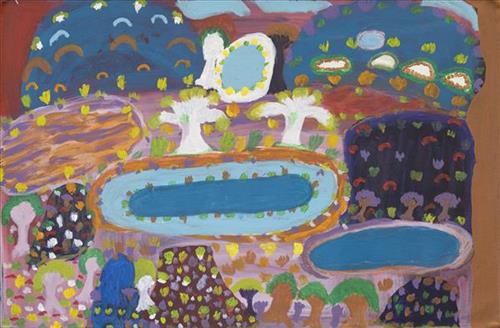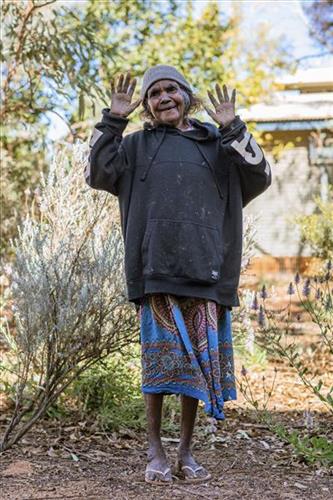111582291198
Wantili (Warntili, Canning Stock Route Well 25)
“This is Wantili (Warntili, Canning Stock Route Well 25), where we been camping with my sisters [Wurta Amy French and Helen Dale Samson]. This is my Country, Amy’s Country; Amy was born here. It’s the hill and all the kapi (water). This one big Country, big area. Water been running, rolling, rolling from these hills here. Trees and spinifex, all the bush tucker, all palya (good).
Big Wantili in the middle, big kapi we been come in over the sand hill side then we don’t go in because of the big kapi. Sandhills on both sides. We thought we were going to drown- all this kapi! Kartujarra people are from one side, other side of clay pan is big community. Everybody go there, everybody’s Country. Warnman, Kartujarra, Putijarra people. They come here Lore time, ceremony time.”
– Jatarr Lily Long
Wantili is a large round jurnu (soak) and linyji (claypan) near Well 25 on the Canning Stock Route. This site lies within Jatarr’s ngurra (home Country, camp), and forms part of the area which she knew intimately and travelled extensively with her family in her youth. Jatarr’s sister Wurta was born here.
The Wantili region is dominated by claypans surrounded by tuwa (sandhills), and Nyilangkurr, a prominent yapu (hill) is located close to the eastern edge of the claypan. Following rain the typically dry claypans are filled with water, with the overflow from nearby waterholes flowing to Wantili. At that time, Wantili becomes an important place for obtaining fresh water for drinking and bathing. As Jatarr describes here, Wantili is significant for the fact that at this site Kartujarra, Manyjilyjarra, Putijarra and Warnman people would all come together for ceremonies during the pujiman (traditional, desert dwelling) era. Many jiwa (stones used by women for grinding seeds) from these times can still be found there today.
Culturally, Wantili is an incredibly important site in two central Jukurrpa (Dreaming) stories. The first relates to the world’s creation. In this narrative, the world was initially dark, and people were like rocks, with no arms or legs. Following the sun’s first rising, life-forms become increasingly complex while particular features in the land are created. Beyond these details much of the narrative is ngurlu (sacred, taboo), and only for Martu, but the site is open, and anyone can go there.
Wantili is also one of the many sites featured in the epic Minyipuru (Jakulyukulyu, Seven Sisters) Jukurrpa story. Minyipuru is a central Jukurrpa narrative for Martu, Ngaanyatjarra, Pitjantjatjara and Yankunytjatjara people that is associated with the seasonal Pleiades star constellation. Relayed in song, dance, stories and paintings, Minyipuru serves as a creation narrative, a source of information relating to the physical properties of the land, and an embodiment of Aboriginal cultural laws. The story follows the movement of a group of women travelling all the way across the desert, beginning at Roebourne on the coast of Western Australia, as they are pursued by Yurla, a lustful old man. As the women travelled, they stopped to rest at many sites to eat, dance, rest and sing, on the way leaving behind an assortment of articles that became formations in the land, such as groupings of rocks and trees, grinding stones and seeds. The sisters rested at Wantili before throwing seeds, then continued their journey far to the east and beyond Martu Country, stopping at various sites through central and South Australia.




